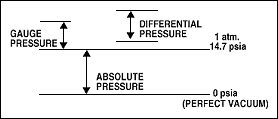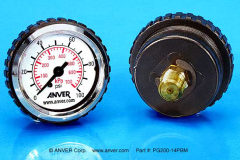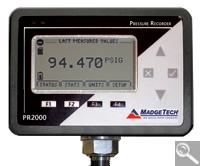Pressure Gauges Information
 Pressure gauges are used for a variety of industrial and application-specific pressure monitoring applications. They can be used for visual monitoring of air and gas pressure for compressors, vacuum equipment, process lines and specialty tank applications such as medical gas cylinders and fire extinguishers. In addition to visual indication, some pressure gauges are configured to provide electrical output of indicated pressure and monitoring of other variables such as temperature.
Pressure gauges are used for a variety of industrial and application-specific pressure monitoring applications. They can be used for visual monitoring of air and gas pressure for compressors, vacuum equipment, process lines and specialty tank applications such as medical gas cylinders and fire extinguishers. In addition to visual indication, some pressure gauges are configured to provide electrical output of indicated pressure and monitoring of other variables such as temperature.
Types of Pressure Gauges
Differential pressure is measured by reading the difference between the inputs of two or more pressure levels. The sensor must have two separate pressure ports; the higher of the two pressures is applied through the high port and the lower through the low port. It is commonly measured in units of pounds per square inch. An example of a differential pressure sensor is a filter monitor; when the filter starts to clog the flow resistance and therefore the pressure drop across the filter will increase.
Absolute pressure sensors measure the pressure of a system relative to a perfect vacuum. These sensors incorporate elements which are completely evacuated and sealed which serve as the vacuum reference. Input pressure is applied through a single port.
Gauge sensors are the most common type of pressure sensor. The pressure is measured relative to ambient pressure which is the atmospheric pressure at a given location. The average atmospheric pressure at sea level is 1013.25 mbar but changes in weather and altitude directly influence the output of the pressure sensor. In this device, the input pressure is through the high port and the ambient pressure is applied through the open low port.
Vacuum sensors are gauge sensors used to measure the pressure lower than the localized atmospheric pressure. A vacuum is a volume of space that is essentially empty of matter. Vacuum sensors are divided into different ranges of low, high and ultra-high vacuum.
Sealed gauged sensors measure pressure relative to one atmosphere at sea level (14.7 PSI). Absolute pressure sensors also have a sealed element that measures pressure relative to a vacuum.

The same sensor can be used for all three types of pressure measurement; only the references differ.
Compound pressure gauges can display positive and negative pressure readings.
Liquid Filled gauges are filled with a liquid such as glycerin or silicone oil to protect the gauge from the harmful effects of vibration and pulsation. They are best used when a system will be under positive and negative pressure (which requires a compound pressure gauge) because a dry gauge will wear out more quickly under the stress and when the system is exposed to vibration. There are several advantages to choosing a liquid filled gauge; liquid steadies the pointer so the gauge is easier to read and it lubricates the internal parts of the gauge so they last longer.
Specifications
 Working pressure range is the maximum allowable pressure at which a system or piece of equipment is designed to operate safely. The extremes of this range should be determined in accordance with the expected pressure range the device must operate within. Most pressure gauges have the highest accuracy in the middle third of the gauge; therefore the selected gauge should have a range about twice the normal operating pressure.
Working pressure range is the maximum allowable pressure at which a system or piece of equipment is designed to operate safely. The extremes of this range should be determined in accordance with the expected pressure range the device must operate within. Most pressure gauges have the highest accuracy in the middle third of the gauge; therefore the selected gauge should have a range about twice the normal operating pressure.
Dial diameter is the diameter of the gauge. The dial size is usually determined by the readability requirements; larger for remote reading and smaller where the gauge is close to the operator. Generally, a requirement for higher accuracy dictates a larger dial size for display of readable small pressure scale increments.
Accuracy is defined as the difference (error) between the true value and the indicated value expressed as percent of the span. It includes the combined deviations resulting from the method, observer, apparatus and environment. Since gauge accuracy is closely related to price, consider the application to determine the accuracy needed. Applications requiring less accurate readings, like in a backyard pool, can use an accuracy of "3-2-3", which means the gauges are accurate to plus or minus 3% in the bottom third and top third of their range, and within 2% in the middle third. Gauge levels can go as accurate as 0.25%.
Vacuum range is the span of pressures from the lowest vacuum pressure to the highest vacuum pressure (e.g., from 0 to 30 inches of mercury VAC).
Operating temperature is important to consider. Buyers should be aware of the ambient and media temperatures in the environment of the sensor. If the sensor is not compensated correctly the reading can change drastically.
Display
The display is the interface the user interacts with to observe the pressure sensor reading.
- Analog meter - The device has an analog meter or simple visual indicator.
- Digital meter - The device has a display for numerical values.
Mount Location
The mount location on the gauge can vary depending on the type of gauge. Selecting the type of mount depends on the application and environment in which the gauge will be used.
- Bottom- This is sometimes called a stem mount, and the mount connection is on the bottom of the gauge.
- Back- Back mounting can be found in the center or lower back of the gauge. The mount connection will protrude from the back of the gauge.
- Flange- The pressure gauge is mounted by a flange around the face or back of the gauge
Scale Type
The scale is located on the face of the analog pressure gauge. Scale can help determine accuracy, with smaller scales leading to more accurate readings. The face of the gauge can have a single or dual scale.
- Single scale pressure gauges have one scale (one set of units) on its face.
- Dual scale pressure gauges have two scales (two sets of units) on its face. This is commonly seen in compound pressure gauges.
Scale Units
Most pressure gauges measure positive pressure is psi, and negative pressure is frequently measured in inches of Hg.
|
Pressure Unit |
|
|
psi |
Pounds per square inch: psi, PSI, lb/in^2, or lb/sq in. |
|
kPa |
kilo Pascals - standard atmospheric pressure is 101,325 Pa or 101.325 kPa |
|
bar |
A unit of measure of atmospheric pressure. One bar is equal to 0.987 atmospheres |
|
inches of Hg |
One inch of mercury is equivalent to 33.86 millibars. |
|
cm of Hg |
A metric measure of pressure. |
|
feet of H2O |
The pressure equivalent for 1 foot of water is .0295 atm |
|
kg/cm2 |
The pressure equivalent for 1 kg/cm2 is .9678 atm |
|
oz/in2 |
The pressure equivalent for 1 atmosphere of pressure is approx. 235 oz / in2 |
|
inches of H2O |
The pressure equivalent for 1 inch of water is .00245 atm |
Sensor Technology
For more detailed information on sensor technologies read Pressure Sensors Information.
Mechanical deflection uses an elastic or flexible element to mechanically deflect with a change in pressure, for example a diaphragm, Bourdon tube, or bellows.
Piston technology uses a sealed piston/cylinder to measure changes in pressure.
Strain gauges (strain-sensitive variable resistors) are bonded to parts of the structure that deform as the pressure changes. Strain gauges are rugged, accurate, and stable, they can operate in severe shock and vibration environments as well as in a variety of pressure media.
Piezoelectric pressure sensors measure dynamic and quasi-static pressures. The bi-directional transducers consist of metallized quartz or ceramic materials which have naturally occurring electrical properties. They are capable of converting stress into an electric potential and vice versa. The sensors can only be used for varying pressures. They are very rugged but require amplification circuitry which can be susceptible to shock and vibration.
Semiconductor piezoelectric sensors are based on semiconductor technology. The change in resistance is not only because of a change in the length and width (as it is with strain gage) but because of a shift of electrical charges within the resistor. These are very sensitive devices.
Thin film sensors have an extremely thin layer of material deposited on a substrate by sputtering, chemical vapor deposition, or other technique. This technology incorporates a compact design with good temperature stability. There are a variety of materials used in thin film technology, such as titanium nitride and polysilicon. These gauges are most suitable for long-term use and harsh measurement conditions.
Microelectromechanical systems (MEMS) are typically micro systems manufactured by silicon surface micromachining for use in very small industrial or biological systems.
Vibrating elements (silicon resonance) use a vibrating element technology, such as silicon resonance.
Variable capacitance pressure instruments use the capacitance change results from the movement of a diaphragm element to measure pressure. Depending on the type of pressure, the capacitive transducer can be either an absolute, gauge, or differential pressure transducer. The device uses a thin diaphragm as one plate of a capacitor. The applied pressure causes the diaphragm to deflect and the capacitance to change. The deflection of the diaphragm causes a change in capacitance that is detected by a bridge circuit.
Media
Analog pressure gauges should be selected considering the media and ambient operating conditions. Gauge selection should take into consideration the corrosive environment in which it is to operate. The media being measured must be compatible with the wetted parts of the pressure instrument. Improper application can damage the analog pressure gauge, causing failure or personal injury and property damage. Diaphragm seals (also called gauge isolators) can be added to the system to protect the gauge from corrosive attack, and prevent viscous or dirty media from clogging Bourdon tube analog pressure gauges.
Features
C ommon features of pressure gauges include adjustable pointers, maximum and minimum pointers, adjustable and stationary set hands, throttling devices, and electric contacts.
ommon features of pressure gauges include adjustable pointers, maximum and minimum pointers, adjustable and stationary set hands, throttling devices, and electric contacts.
- An adjustable pointer has adjustment to zero the pointer via screw or knob.
- A maximum and minimum pointer indicates the maximum or minimum pressure attained.
- An adjustable or stationary set hand is a separate pointer (hand) to indicate a specifically set pressure.
- A throttling device is used to reduce pressure impact and pointer movement caused by pressure pulsation and/or vibration. Throttling effect is obtained by installing a restricting orifice between the gauge socket connection and the Bourdon tube. Some types of throttling devices are throttling screws, pulsation dampeners, elastomeric bladders, pressure snubbers and needle valves.
- Electric contacts are used to turn on signal lights, sound alarms, or operate pumps or valves.
References
Dale Foster Pressure Gauges - How to Buy a Pressure Gauge
Engineering360 - Pressure Sensors Information
Image credits:
Sensorsmag | Anver | Winters | Linseis
- Alabama
- Arizona
- California
- Colorado
- Connecticut
- Delaware
- Florida
- Georgia
- Iowa
- Idaho
- Illinois
- Indiana
- Kansas
- Kentucky
- Louisiana
- Massachusetts
- Maryland
- Michigan
- Minnesota
- Missouri
- Montana
- North Carolina
- Nebraska
- New Hampshire
- New Jersey
- New Mexico
- Nevada
- New York
- Ohio
- Oklahoma
- Oregon
- Pennsylvania
- South Carolina
- South Dakota
- Tennessee
- Texas
- Utah
- Virginia
- Washington
- Wisconsin
- West Virginia
- Wyoming
- Absolute
- Analog
- Bottom
- Center Back
- Compound
- Differential
- Digital
- Flange
- Gas
- Gauge
- Hazardous
- Liquid
- Liquid Filled
- Lower Back
- MEMS
- Mechanical Deflection
- Piezoelectric
- Piston
- Sealed
- Semiconductor Piezoresistive
- Strain Gauge
- Vacuum
- Variable Capacitance
- bar
- cm of Hg
- feet of H2O
- inches of H2O
- inches of Hg
- kPa
- kg/cm2
- oz./in2
- psi
- sight glass
- digital air pressure gauge
- electric oil pressure gauge
- compound pressure gauge
- fluid pressure gauge
- steam pressure gauge
- hydraulic pressure gauge
- natural gas pressure gauge
- high pressure gauge
- boiler draft gauge
- wireless pressure gauge
- air bladder cylinder
- chimney draft gauge
- cng pressure gauges
- emerson pressure gauge
- flue draft gauge
- liquid filled pressure gauge
- manifold pressure gauge
- MEMS compressor
- micro air pressure gauge
- miniature pressure gauge
- panel pressure gauge
- tank-o-meter
- 2 PSI pressure gauge
- digital hydraulic pressure gauge
- radiator pressure gauges
- 0-10 PSI pressure gauges
- 0-15 PSI pressure gauges
- 0-160 PSI pressure gauges
- 0-2 PSI pressure gauges
